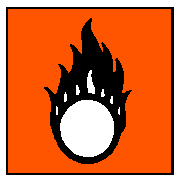International Chemical Safety Cards
| SODIUM NITRITE | ICSC: 1120 |
SODIUM NITRITE |
 |
 |
| TYPES OF HAZARD/ EXPOSURE |
ACUTE HAZARDS/ SYMPTOMS |
PREVENTION | FIRST AID/ FIRE FIGHTING |
| FIRE | Not combustible but enhances
combustion of other substances. Many reactions may cause fire or explosion. Gives off
irritating or toxic fumes (or gases) in a fire. |
NO contact with combustible
substances. |
Water in large amounts, powder,
water spray, foam, carbon dioxide. In case of fire in the surroundings: all extinguishing
agents allowed. |
| EXPLOSION | |
|
In case of fire: keep drums,
etc., cool by spraying with water. |
| EXPOSURE | |
PREVENT DISPERSION OF DUST! |
|
| INHALATION | Blue lips or finger nails. Blue
skin. Cough. Dizziness. Headache. Laboured breathing. Unconsciousness. |
Local exhaust or breathing
protection. |
Fresh air, rest. Artificial
respiration if indicated. Refer for medical attention. |
| SKIN | MAY BE ABSORBED! Redness
(further see Inhalation). |
Protective gloves. Protective
clothing. |
First rinse with plenty of
water, then remove contaminated clothes and rinse again. Wear protective gloves when
administering first aid. |
| EYES | Redness. |
Safety goggles or eye protection
in combination with breathing protection. |
First rinse with plenty of water
for several minutes (remove contact lenses if easily possible), then take to a doctor. |
| INGESTION | Abdominal pain. Blue lips or
fingernails. Blue skin. Diarrhoea. Dizziness. Headache. Laboured breathing.
Unconsciousness. Vomiting. Rapid pulse. Rapid drop in blood pressure. |
Do not eat, drink, or smoke
during work. |
Do NOT induce vomiting. Give
nothing to drink. Refer for medical attention. |
| SPILLAGE DISPOSAL | STORAGE | PACKAGING & LABELLING | ||
| Do NOT wash away into sewer.
Sweep spilled substance into containers. Carefully collect remainder, then remove to
safe place. Do NOT absorb in saw-dust or other combustible absorbents (extra personal
protection: self-contained breathing apparatus). |
Fireproof. Separated from
combustible and reducing substances, acids. Cool. Dry. Well closed. |
Airtight. O symbol T symbol R: 8-25 S: 44 UN Hazard Class: 5.1 UN Packing Group: III |
||
| SEE IMPORTANT INFORMATION ON BACK | ||||
|
||||